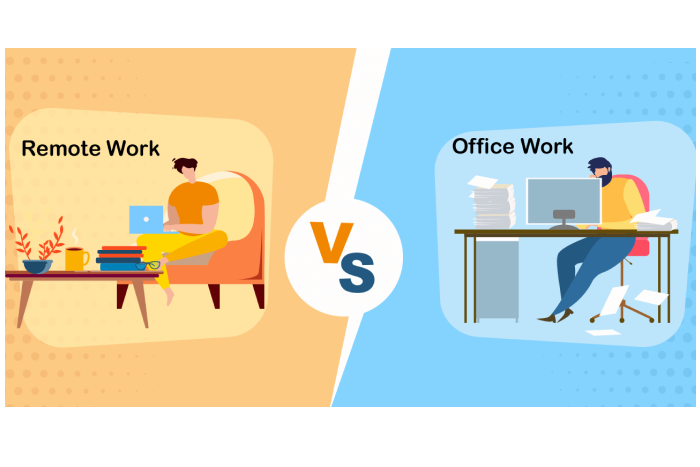An increasing number of people are realizing the advantages of working remotely from home as remote work continues to gain traction. However, how can you make the most of your remote work experience and prosper in this new setting? And what will be the future of remote work?
We’ll look at methods for balancing work and life, increasing productivity, and using technology and apps to facilitate remote work in this blog article.
Key Points:
- The practice of working remotely is growing in popularity because it offers workers more freedom, autonomy, and career prospects while opening up new business opportunities for employers.
- For remote workers to be as productive as possible, time management, communication apps, and virtual social interaction are crucial.
- Through establishing clear expectations, offering resources for feedback, recognizing accomplishments, and conducting effective performance evaluations, managers can help teams develop a sense of trust and accountability.
Remote Work Statistics And Trends:

The nature of work has changed significantly in recent years, with remote employment growing in popularity among employers and employees alike.
The main reason for this change is technology, since it has made it possible for people to work from almost anywhere in the world.
Companies are responding to worker demands for greater flexibility, autonomy, and work-life balance by expanding their remote work options.
As a result, handling remote work has taken center stage in human resources departments all over the world.
Businesses are operating differently as a result of the growing trend toward remote work, which presents both new opportunities and difficulties for both employers and employees.
Everyone can benefit from remote work if they have the appropriate techniques and resources.
The advantages of working remotely:

The numerous advantages of remote work are the reason for its growing popularity.
Since they have more control over their schedules and can more effectively manage their personal and professional obligations, employees working remotely may experience an improvement in work-life balance.
Since there are fewer distractions at work, employees may be more satisfied with their jobs, which can also result from greater flexibility.
Key Benefits of Remote Work for Employees, such as:
- Time Saving: Working from home can save a lot of time for both employers and employees. Every morning, getting ready for work can take several hours. In addition, spending a significant amount of the day driving to and from work takes up time. Businesses can meet deadlines and be more productive with all this extra time. The additional time that employees have for their personal lives may also make them happier.
- Work-Life Balance: The ability to attain a better work-life balance is a significant benefit of working remotely since remote workers can organize their schedules to suit their unique requirements and preferences. Employees can do that because remote work offers flexibility. Manage personal affairs, like taking care of family members or going to appointments, without neglecting their work obligations. They possess greater authority over their work schedule and surroundings. Stay away from long commutes and the tension they cause. Also establish a more wholesome work-life balance. Cut down on burnout and stress at work.
- Cost Savings: Employers and employees alike can save a great deal of money by implementing remote work. Employees can save thousands of dollars a year on transportation, eating out, and other work-related expenses by working remotely. These cost savings can be passed on to clients in the form of cheaper costs or better services, or they can be invested in other areas of the company, like staff training and development. Over time, remote work has the potential to strengthen a business model that is advantageous to both employers and employees.

Benefits and challenges of work from home: The Future of Remote Work
Despite the many advantages, certain challenges of working remotely must be tackled to optimize productivity and sustain a balanced work-life routine.
One of the most common challenges faced by individuals who work from home is the feeling of isolation and the difficulty in maintaining social connections with colleagues. Communication can also be a challenge, as remote workers may struggle to stay connected and collaborate effectively with their teams.
Fortunately, there are solutions available to help individuals who work remotely overcome these challenges.
Interaction and cooperation:
For remote workers to successfully manage the difficulties of working from home and guarantee the success of their teams, effective communication and collaboration are crucial. Employees working remotely can stay in touch and work together effectively by using tools such as Microsoft Teams, Zoom, and Slack.
Despite geographical limitations, remote teams can collaborate on projects, share files, and communicate in real time thanks to these platforms.
Through the use of these tools and technologies, remote workers can improve teamwork and overcome communication obstacles. In the end, this may result in higher output, better team dynamics, and a more fruitful remote workplace.

Technologies and tools for productive remote work:
With the correct digital tools, remote work can be successful. In order for remote teams to stay in touch and oversee projects, communication and collaboration tools are essential. To help remote workers stay organized and meet deadlines, task tracking and project management software are also helpful.
Learn more about these essential working from home apps.
Apps for cooperation and communication:
Tools for cooperation and communication are used by remote teams, such as:
Slack: for sharing files and real-time communication
Zoom: for screen sharing and video conferences
Microsoft Teams: for file storage, video calls, and chat
These tools facilitate effective communication and teamwork among remote employees. It’s critical to select a tool that meets the unique requirements and preferences of the team.

Software for task tracking and project management:
To stay organized, manage their responsibilities, and meet deadlines, people with remote jobs need to use task tracking and project management apps like Trello and Asana.
These platforms give remote workers a centralized location to manage and keep an eye on assignments, making it easier for them to assign tasks, distribute resources, and monitor progress.
Remote workers can keep a clear picture of their workload and priorities by using these tools to make sure they are staying on track with their assignments and projects.
Since fully remote workers can concentrate on their most critical tasks and reduce the chance of procrastination or missed deadlines, this can ultimately result in increased productivity and efficiency.
FAQ:
Is it worthwhile to work remotely if your job type permits it?
Many benefits come with working remotely, such as higher output, a better work-life balance, reduced stress, and lower transportation expenses. Employees who have more control over their schedules also save more money on other costs such as dry cleaning, pet care, and meals.
What is a style of remote work?
Professionals can carry out their work remotely from any location outside of the conventional corporate office building or campus, such as an employee’s home, a co-working space or other shared area, or a private office. Its foundation is the idea that work can be done successfully without having to be done in a particular location.
What are the primary advantages of working remotely?
The primary advantages of working remotely include better health, more output and job satisfaction, financial savings, less stress from commuting, and more freedom and autonomy.
How can employees working remotely maintain communication and productive teamwork?
By using communication and collaboration tools like Slack, Zoom, and Microsoft Teams, employees who work remotely can remain in touch and work productively with their coworkers.
